

***Description for this perennial available with future update!***Hummelo Stachys (small), is also known as Stachys monieri / officinalis 'Hummelo'
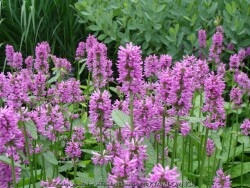

***Description for this perennial available with future update!***Hummelo Stachys (flat), is also known as Stachys monieri / officinalis 'Hummelo'


***Description for this perennial available with future update!***Hummelo Stachys (large), is also known as Stachys monieri / officinalis 'Hummelo'
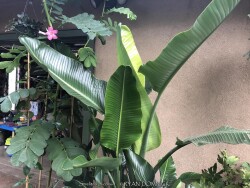

***Description for this plant available with future update!***White Bird of Paradise (Tropical), is also known as Strelitzia nicolai


***Description for this perennial available with future update!*** Stylophorum diphyllum is also known as Yellow Woodland Poppy / Celandine Poppy >>>>>>>>>>>>For the home garden, the species is generally too aggressive to mix with other plants
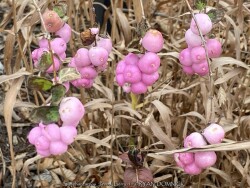

Coralberry (Symphoricarpos orbiculatus) is a spreading dwarf shrub native to much of the central and eastern United States including Kansas. It features mint green leaves that remain attractive all summer. Light pink flowers are barely noticeable but attractive upon close inspection. Ornamental clusters of magenta berries in the fall are the main attraction! The berries are very freeze-hardy clinging onto the leafless stems throughout most of the winter regardless of the minimum temperatures. This creates quite a show providing excellent color and interest to the winter landscape. While edible for some birds including robins, they seem to avoid the fruits unless it's a last resort. Coralberry is commonly grown as a spreading groundcover shrub for difficult areas. It will grow in full sun or full shade in medium to dry soils including dry-shade. It tolerates moist soil and floods for short periods of time. Fall leaf color is non-existent but ok because of the berry display. A brief window of time exists in the fall where the plant has beautiful green foliage and contrasting magenta berries at the same time. In the landscape, it is commonly used as large mass planting on hills. Because of its tolerance for adverse conditions including poor soil and rock, it is often one of the last resort plants that will survive in certain areas. It competes well under large shade trees and helps absorb leaf litter allowing it to break down and add nutrients back to the soil. This plant also does well in full sun; berry density is much greater in full sun. Plants can also be planted on the north side of a house, being extremely cold hardy with no winterkill. Another great spot is planting on top of a retaining wall allowing it to cascade down. We do not recommend planting in small areas or in spaces that it will overrun neighboring plants. It only spreads above ground as horizontally growing stems touch the ground and root. This does make maintenance easier to control the spread of the plant versus digging out rhizomes. Considered one of the best plants for solving your most difficult dry-shade landscape challenges. Proud Berry Pink Coralberry (Symphoricarpos 'Proud Berry') is a Proven Winners® selection that has much larger pink berries in large clusters. Fruit lasts into December but is quicker to dessicate than the true native magenta coralberry. All Proven Winners® plants are legally propagated, healthy and vigorous, true to name, and tagged with color pictures and growing information.
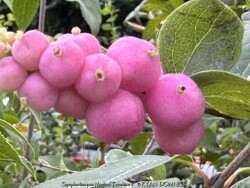

Magical Treasure Snowberry / Coralberry (Symphoricarpos doornsbosii ‘Magical Treasure’) is a spreading dwarf shrub native to much of the northern and central United States. It features mint green leaves that remain attractive all summer. Light pink flowers are barely noticeable but attractive upon close inspection. Ornamental clusters of magenta berries in the fall are the main attraction! The berries are very freeze-hardy clinging onto the leafless stems throughout most of the winter regardless of the minimum temperatures. This creates quite a show providing excellent color and interest to the winter landscape. While edible for some birds including robins, they seem to avoid the fruits unless it's a last resort. Coralberry is commonly grown as a spreading groundcover shrub for difficult areas. It will grow in full sun or full shade in medium to dry soils including dry-shade. It tolerates moist soil and floods for short periods of time. Fall leaf color is non-existent but ok because of the berry display. A brief window of time exists in the fall where the plant has beautiful green foliage and contrasting magenta berries at the same time. In the landscape, it is commonly used as large mass planting on hills. Because of its tolerance for adverse conditions including poor soil and rock, it is often one of the last resort plants that will survive in certain areas. It competes well under large shade trees and helps absorb leaf litter allowing it to break down and add nutrients back to the soil. This plant also does well in full sun; berry density is much greater in full sun. Plants can also be planted on the north side of a house, being extremely cold hardy with no winterkill. Another great spot is planting on top of a retaining wall allowing it to cascade down. We do not recommend planting in small areas or in spaces that it will overrun neighboring plants. It only spreads above ground as horizontally growing stems touch the ground and root. This does make maintenance easier to control the spread of the plant versus digging out rhizomes. Considered one of the best plants for solving your most difficult dry-shade landscape challenges. Magical Treasure Snowberry / Coralberry in a dwarf variety maxing out at 18-24" tall. Berries are larger and more colorful than the species, providing a great source of autumn cut stems for fall arrangements. Full sun will increase ornamental autumn fruit production without as much foliage furn.
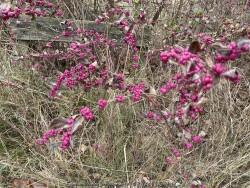

Coralberry (Symphoricarpos orbiculatus) is a spreading dwarf shrub native to much of the central and eastern United States including Kansas. It features mint green leaves that remain attractive all summer. Light pink flowers are barely noticeable but attractive upon close inspection. Ornamental clusters of magenta berries in the fall are the main attraction! The berries are very freeze-hardy clinging onto the leafless stems throughout most of the winter regardless of the minimum temperatures. This creates quite a show providing excellent color and interest to the winter landscape. While edible for some birds including robins, they seem to avoid the fruits unless it's a last resort. Coralberry is commonly grown as a spreading groundcover shrub for difficult areas. It will grow in full sun or full shade in medium to dry soils including dry-shade. It tolerates moist soil and floods for short periods of time. Fall leaf color is non-existent but ok because of the berry display. A brief window of time exists in the fall where the plant has beautiful green foliage and contrasting magenta berries at the same time. In the landscape, it is commonly used as large mass planting on hills. Because of its tolerance for adverse conditions including poor soil and rock, it is often one of the last resort plants that will survive in certain areas. It competes well under large shade trees and helps absorb leaf litter allowing it to break down and add nutrients back to the soil. This plant also does well in full sun; berry density is much greater in full sun. Plants can also be planted on the north side of a house, being extremely cold hardy with no winterkill. Another great spot is planting on top of a retaining wall allowing it to cascade down. We do not recommend planting in small areas or in spaces that it will overrun neighboring plants. It only spreads above ground as horizontally growing stems touch the ground and root. This does make maintenance easier to control the spread of the plant versus digging out rhizomes. Considered one of the best plants for solving your most difficult dry-shade landscape challenges.


***Description for this perennial available with future update!*** Symphyotrichum / Aster novae-belgii 'Grape Crush' is also known as Grape Crush Aster >>>>> >>>>>> This fall blooming aster does not splay open like other Asters can. According to Walters Gardens "Bringing refinement to fall blooming Asters, 'Grape Crush' produces a large, very round mound with densely packed flowers. We have observed no lodging in our trials, a phenomenal achievement for fall blooming Asters. Very rich, dark purple flowers are produced above dark green foliage in early fall to midfall. A perfect finale to the growing season!" Asters are native to North America and are generally very easy to grow.
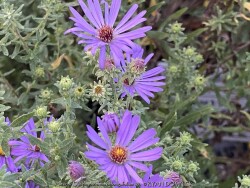

***Description for this perennial available with future update!*** Symphyotrichum oblongifolium / Aster oblongifolium is also known as Aromatic Aster.


***Description for this perennial available with future update!*** Symphyotrichum pilosum / Aster pilosum is also known as Frost aster / Hairy Aster.
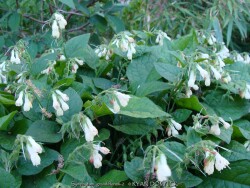

Dry Shade Comfrey / Large-Flowered Comfrey (Symphytum grandiflorum) is a perennial native to Europe with textured sandpapery green leaves and light yellow flowers. It spreads by creeping rhizomes and forms an attractive groundcover. Foliage is quite dense forming a tight weed resistant covering. Comfrey prefers rich average to moist well-drained soils with part sun to full shade. However, being a tolerant plant, is very adaptable to both dry and moist locations and will grow quite nicely in dry shade. It is not particular as to soil type or pH. and is highly tolerant of urban pollution and will even thrive in inner city environments. There is virtually no maintenance unless you want to mow down the dead foliage in the winter. It is also suggested to deadhead the flowers after blooming as they are not attractive. But if you don't, they will die back on their own and get swallowed up by the foliage. In addition to being a great perennial for your landscape, this comfrey may have herbal uses as well. There are no pest, disease, or browser problems. Considered one of the best plants for solving your most difficult dry-shade landscape challenges. The blue variety, Symphytum grandiflorum 'Hidcote Blue', has more of a blue green foliage and light blue flowers on taller flower spikes. Spread is also more rapid and sometimes to the point of aggressive and rich moist soil. Comfrey is a great underused plant worthy of more wide scale use in the landscape. Dry Shade Comfrey has persisted through over a decade in our Lawrence, KS display garden with no problems.
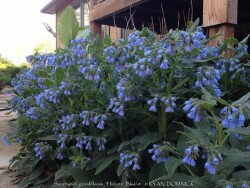

Dry Shade Comfrey / Large-Flowered Comfrey (Symphytum grandiflorum) is a perennial native to Europe with textured sandpapery green leaves and light yellow flowers. It spreads by creeping rhizomes and forms an attractive groundcover. Foliage is quite dense forming a tight weed resistant covering. Comfrey prefers rich average to moist well-drained soils with part sun to full shade. However, being a tolerant plant, is very adaptable to both dry and moist locations and will grow quite nicely in dry shade. It is not particular as to soil type or pH. and is highly tolerant of urban pollution and will even thrive in inner city environments. There is virtually no maintenance unless you want to mow down the dead foliage in the winter. It is also suggested to deadhead the flowers after blooming as they are not attractive. But if you don't, they will die back on their own and get swallowed up by the foliage. In addition to being a great perennial for your landscape, this comfrey may have herbal uses as well. There are no pest, disease, or browser problems. Considered one of the best plants for solving your most difficult dry-shade landscape challenges. The blue variety, Symphytum grandiflorum 'Hidcote Blue', has more of a blue green foliage and light blue flowers on taller flower spikes. Spread is also more rapid and sometimes to the point of aggressive and rich moist soil. Comfrey is a great underused plant worthy of more wide scale use in the landscape. Dry Shade Comfrey has persisted through over a decade in our Lawrence, KS display garden with no problems.
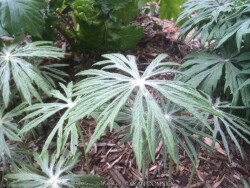

Japanese Shredded Umbrella Plant (Syneilesis aconitifolia) is a perennial with bright green dissected leaves cascade downward like an umbrella. Emerging foliage is covered with a unique white fur. It spreads very slowly by creeping rhizomes that form a tight clump after many years. Fine-textured foliage is quite dense; it forming a tight weed resistant covering. White flowers on mauve pink calyxes tower above the foliage in midsummer but are not especially attractive unless viewed up close. Some gardeners cut the flowers promptly to avoid distraction from the amazing foliage. Japanese Shredded Umbrella Plant prefers rich average to moist well-drained soils with morning sun to full shade. However, being a tolerant plant, is adaptable to both dry and moist locations and will grow quite nicely in mild dry shade. It is not particular as to soil type or pH. There is virtually no maintenance accept cutting down in fall after the first hard freeze. It is also suggested that if allowing flowering to occur, to deadhead the flowers after blooming as they are not attractive either. There are no pest, disease, or browser problems. This plant is a great underused specimen for the shade garden worthy of more wide scale use in the landscape. Having persisted in our Lawrence, KS display garden with no problems for over a decade, this is a "must have" if and when available to purchase!
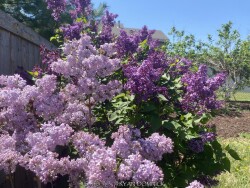

***Shrub descriptions available with future update!*** Syringa vulgaris is also known as Common Purple Lilac >>>>>>>>>>>>Ultra cold-hardy plants from northern climates normally dislike our long hot humid summers; although we are on the Southern edge of this plants adaptability, it still survives reasonably well here. Look for a cold microclimate planting location such as East or North exposure.>>>>>
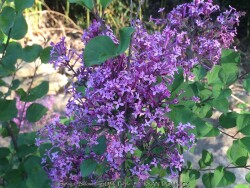

***Shrub descriptions available with future update!***Bloomerang Reblooming Dark Purple Lilac, is also known as Syringa x 'Bloomerang Dark Purple'